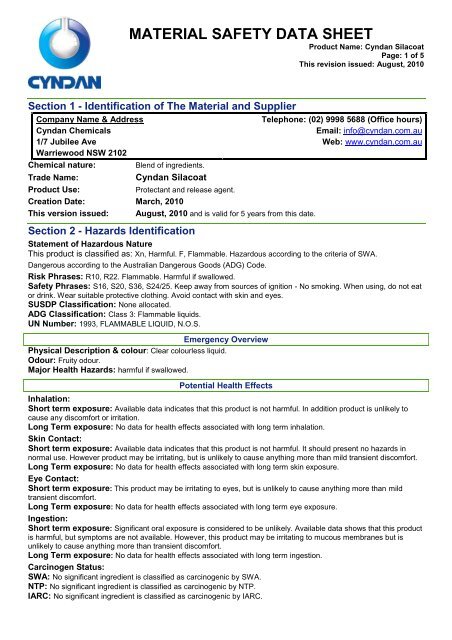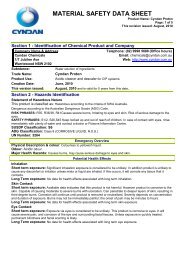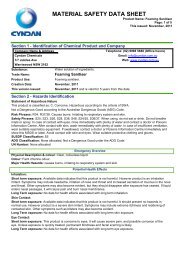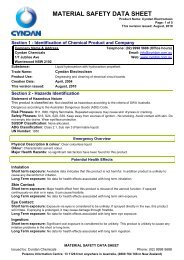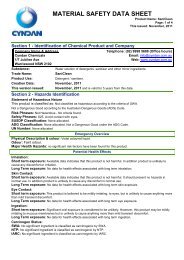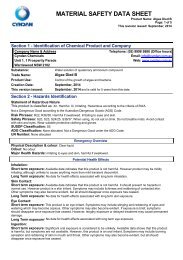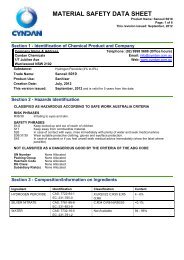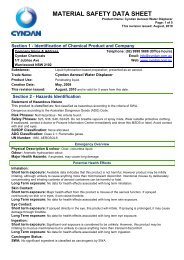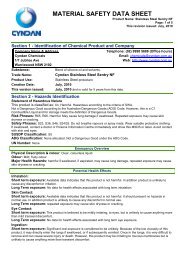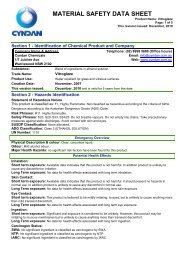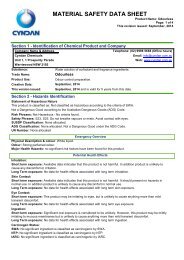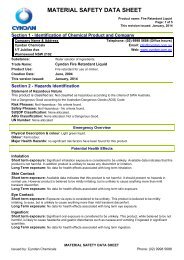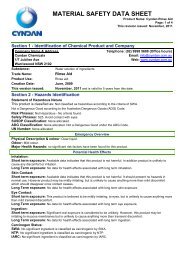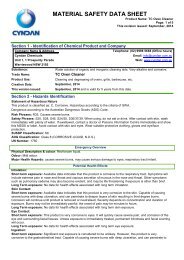Silacoat - MSDS - CYNDAN Chemicals
Silacoat - MSDS - CYNDAN Chemicals
Silacoat - MSDS - CYNDAN Chemicals
Create successful ePaper yourself
Turn your PDF publications into a flip-book with our unique Google optimized e-Paper software.
MATERIAL SAFETY DATA SHEET<br />
Product Name: Cyndan <strong>Silacoat</strong><br />
Page: 1 of 5<br />
This revision issued: August, 2010<br />
Section 1 - Identification of The Material and Supplier<br />
Company Name & Address<br />
Cyndan <strong>Chemicals</strong><br />
1/7 Jubilee Ave<br />
Warriewood NSW 2102<br />
Chemical nature:<br />
Blend of ingredients.<br />
Trade Name:<br />
Cyndan <strong>Silacoat</strong><br />
Product Use:<br />
Protectant and release agent.<br />
Creation Date: March, 2010<br />
This version issued: August, 2010 and is valid for 5 years from this date.<br />
Telephone: (02) 9998 5688 (Office hours)<br />
Email: info@cyndan.com.au<br />
Web: www.cyndan.com.au<br />
Section 2 - Hazards Identification<br />
Statement of Hazardous Nature<br />
This product is classified as: Xn, Harmful. F, Flammable. Hazardous according to the criteria of SWA.<br />
Dangerous according to the Australian Dangerous Goods (ADG) Code.<br />
Risk Phrases: R10, R22. Flammable. Harmful if swallowed.<br />
Safety Phrases: S16, S20, S36, S24/25. Keep away from sources of ignition - No smoking. When using, do not eat<br />
or drink. Wear suitable protective clothing. Avoid contact with skin and eyes.<br />
SUSDP Classification: None allocated.<br />
ADG Classification: Class 3: Flammable liquids.<br />
UN Number: 1993, FLAMMABLE LIQUID, N.O.S.<br />
Emergency Overview<br />
Physical Description & colour: Clear colourless liquid.<br />
Odour: Fruity odour.<br />
Major Health Hazards: harmful if swallowed.<br />
Potential Health Effects<br />
Inhalation:<br />
Short term exposure: Available data indicates that this product is not harmful. In addition product is unlikely to<br />
cause any discomfort or irritation.<br />
Long Term exposure: No data for health effects associated with long term inhalation.<br />
Skin Contact:<br />
Short term exposure: Available data indicates that this product is not harmful. It should present no hazards in<br />
normal use. However product may be irritating, but is unlikely to cause anything more than mild transient discomfort.<br />
Long Term exposure: No data for health effects associated with long term skin exposure.<br />
Eye Contact:<br />
Short term exposure: This product may be irritating to eyes, but is unlikely to cause anything more than mild<br />
transient discomfort.<br />
Long Term exposure: No data for health effects associated with long term eye exposure.<br />
Ingestion:<br />
Short term exposure: Significant oral exposure is considered to be unlikely. Available data shows that this product<br />
is harmful, but symptoms are not available. However, this product may be irritating to mucous membranes but is<br />
unlikely to cause anything more than transient discomfort.<br />
Long Term exposure: No data for health effects associated with long term ingestion.<br />
Carcinogen Status:<br />
SWA: No significant ingredient is classified as carcinogenic by SWA.<br />
NTP: No significant ingredient is classified as carcinogenic by NTP.<br />
IARC: No significant ingredient is classified as carcinogenic by IARC.
Product Name: Cyndan <strong>Silacoat</strong><br />
Page: 2 of 5<br />
This revision issued: August, 2010<br />
Section 3 - Composition/Information on Ingredients<br />
Ingredients CAS No Conc,% TWA (mg/m 3 ) STEL (mg/m 3 )<br />
Liquid hydrocarbon 8052-41-3 60-80 790 not set<br />
Silicone oil secret 20-40 not set not set<br />
Other non hazardous ingredients secret to 100 not set not set<br />
This is a commercial product whose exact ratio of components may vary slightly. Minor quantities of other non<br />
hazardous ingredients are also possible.<br />
The SWA TWA exposure value is the average airborne concentration of a particular substance when calculated over a normal 8 hour working day<br />
for a 5 day working week. The STEL (Short Term Exposure Limit) is an exposure value that may be equalled (but should not be exceeded) for no<br />
longer than 15 minutes and should not be repeated more than 4 times per day. There should be at least 60 minutes between successive exposures<br />
at the STEL. The term "peak "is used when the TWA limit, because of the rapid action of the substance, should never be exceeded, even briefly.<br />
Section 4 - First Aid Measures<br />
General Information:<br />
You should call The Poisons Information Centre if you feel that you may have been poisoned, burned or irritated by<br />
this product. The number is 13 1126 from anywhere in Australia (0800 764 766 in New Zealand) and is available at all<br />
times. Have this <strong>MSDS</strong> with you when you call.<br />
Inhalation: First aid is not generally required. If in doubt, contact a Poisons Information Centre or a doctor.<br />
Skin Contact: Gently blot away excess liquid. Wash gently and thoroughly with water (use non-abrasive soap if<br />
necessary) for 5 minutes or until chemical is removed.<br />
Eye Contact: Quickly and gently blot material from eyes. No effects expected. If irritation does occur, flush<br />
contaminated eye(s) with lukewarm, gently flowing water for 5 minutes or until the product is removed. Obtain medical<br />
advice if irritation becomes painful or lasts more than a few minutes. Take special care if exposed person is wearing<br />
contact lenses.<br />
Ingestion: If swallowed, do NOT induce vomiting. Wash mouth with water and contact a Poisons Information<br />
Centre, or call a doctor.<br />
Section 5 - Fire Fighting Measures<br />
Fire and Explosion Hazards: This product is classified as flammable. There is a moderate risk of an explosion<br />
from this product if commercial quantities are involved in a fire. Firefighters should take care and appropriate<br />
precautions. Any explosion will likely spread the fire to surrounding materials. Water spray may be used to cool drums<br />
involved in a fire, reducing the chances of an explosion. Violent steam generation or eruption may occur upon<br />
application of direct water stream on hot liquids. Vapours from this product are heavier than air and may accumulate<br />
in sumps, pits and other low-lying spaces, forming potentially explosive mixtures. They may also flash back<br />
considerable distances.<br />
Fire decomposition products from this product may be toxic if inhaled. Take appropriate protective measures.<br />
Extinguishing Media: Suitable extinguishing media are carbon dioxide, dry chemical, foam, water fog. Alcohol<br />
resistant foam is the preferred firefighting medium but, if it is not available, normal foam can be used. Try to contain<br />
spills, minimise spillage entering drains or water courses.<br />
Fire Fighting: If a significant quantity of this product is involved in a fire, call the fire brigade. There is a danger of a<br />
violent reaction or explosion if significant quantities of this product are involved in a fire. Recommended personal<br />
protective equipment is full fire kit and breathing apparatus.<br />
Flash point: 35°C<br />
Upper Flammability Limit: No data.<br />
Lower Flammability Limit:<br />
Autoignition temperature:<br />
Flammability Class:<br />
No data.<br />
No data.<br />
Flammable<br />
Section 6 - Accidental Release Measures<br />
Accidental release: In the event of a major spill, prevent spillage from entering drains or water courses. Evacuate<br />
the spill area and deny entry to unnecessary and unprotected personnel. Immediately call the Fire Brigade. As a<br />
minimum, wear overalls, goggles and gloves. Suitable materials for protective clothing include rubber, PVC. Eye/face<br />
protective equipment should comprise as a minimum, protective goggles. If there is a significant chance that vapours<br />
or mists are likely to build up in the cleanup area, we recommend that you use a respirator. Usually, no respirator is<br />
necessary when using this product. However, if you have any doubts consult the Australian Standard mentioned<br />
below (section 8).<br />
Stop leak if safe to do so, and contain spill. Absorb onto sand, vermiculite or other suitable absorbent material. If spill<br />
is too large or if absorbent material is not available, try to create a dike to stop material spreading or going into drains<br />
MATERIAL SAFETY DATA SHEET<br />
Issued by: Cyndan <strong>Chemicals</strong> Phone: (02) 9998 5688<br />
Poisons Information Centre: 13 1126 from anywhere in Australia, (0800 764 766 in New Zealand)
Product Name: Cyndan <strong>Silacoat</strong><br />
Page: 3 of 5<br />
This revision issued: August, 2010<br />
or waterways. Avoid using sawdust or other combustible material. Any electrical equipment should be non-sparking.<br />
Any equipment capable of building an electrostatic charge should be electrically grounded. Sweep up and shovel or<br />
collect recoverable product into labelled containers for recycling or salvage, and dispose of promptly. Recycle<br />
containers wherever possible after careful cleaning. After spills, wash area preventing runoff from entering drains. If a<br />
significant quantity of material enters drains, advise emergency services. This material may be suitable for approved<br />
landfill. Ensure legality of disposal by consulting regulations prior to disposal. Thoroughly launder protective clothing<br />
before storage or re-use. Advise laundry of nature of contamination when sending contaminated clothing to laundry.<br />
Section 7 - Handling and Storage<br />
Handling: Keep exposure to this product to a minimum, and minimise the quantities kept in work areas. Check<br />
Section 8 of this <strong>MSDS</strong> for details of personal protective measures, and make sure that those measures are followed.<br />
The measures detailed below under "Storage" should be followed during handling in order to minimise risks to<br />
persons using the product in the workplace. Also, avoid contact or contamination of product with incompatible<br />
materials listed in Section 10.<br />
Storage: Store in a cool, well ventilated area, and make sure that surrounding electrical devices and switches are<br />
suitable. Check containers periodically for leaks. Containers should be kept closed in order to minimise contamination<br />
and possible evaporation. Make sure that the product does not come into contact with substances listed under<br />
"Incompatibilities" in Section 10. If you keep more than 10000kg or L of Dangerous Goods of Packaging Group III, you<br />
may be required to license the premises or notify your Dangerous Goods authority. If you have any doubts, we<br />
suggest you contact your Dangerous Goods authority in order to clarify your obligations. Check packaging - there may<br />
be further storage instructions on the label.<br />
Section 8 - Exposure Controls and Personal Protection<br />
The following Australian Standards will provide general advice regarding safety clothing and equipment:<br />
Respiratory equipment: AS/NZS 1715, Protective Gloves: AS 2161, Industrial Clothing: AS2919, Industrial Eye<br />
Protection: AS1336 and AS/NZS 1337, Occupational Protective Footwear: AS/NZS2210.<br />
SWA Exposure limits TWA (mg/m 3 ) STEL (mg/m 3 )<br />
Liquid hydrocarbon 790 not set<br />
No special equipment is usually needed when occasionally handling small quantities. The following instructions are<br />
for bulk handling or where regular exposure in an occupational setting occurs without proper containment systems.<br />
Ventilation: This product should only be used in a well ventilated area. If natural ventilation is inadequate, use of a<br />
fan is suggested.<br />
Eye Protection: Eye protection such as protective glasses or goggles is recommended when this product is being<br />
used.<br />
Skin Protection: You should avoid contact even with mild skin irritants. Therefore you should wear suitable<br />
impervious elbow-length gloves and facial protection when handling this product. See below for suitable material<br />
types.<br />
Protective Material Types: We suggest that protective clothing be made from the following materials: rubber,<br />
PVC.<br />
Respirator: Usually, no respirator is necessary when using this product. However, if you have any doubts consult<br />
the Australian Standard mentioned above.<br />
Safety deluge showers should, if practical, be provided near to where this product is being used.<br />
Section 9 - Physical and Chemical Properties:<br />
Physical Description & colour: Clear colourless liquid.<br />
Odour:<br />
Fruity odour.<br />
Boiling Point:<br />
Not available.<br />
Freezing/Melting Point: No specific data. Liquid at normal temperatures.<br />
Volatiles:<br />
No data.<br />
Vapour Pressure:<br />
No data.<br />
Vapour Density:<br />
No data.<br />
Specific Gravity: No data. Expected to be about 1.0<br />
Water Solubility:<br />
Insoluble.<br />
pH:<br />
No data.<br />
Volatility:<br />
No data.<br />
Odour Threshold:<br />
No data.<br />
Evaporation Rate:<br />
No data.<br />
Coeff Oil/water distribution: No data<br />
Autoignition temp:<br />
No data.<br />
MATERIAL SAFETY DATA SHEET<br />
Issued by: Cyndan <strong>Chemicals</strong> Phone: (02) 9998 5688<br />
Poisons Information Centre: 13 1126 from anywhere in Australia, (0800 764 766 in New Zealand)
Product Name: Cyndan <strong>Silacoat</strong><br />
Page: 4 of 5<br />
This revision issued: August, 2010<br />
Section 10 - Stability and Reactivity<br />
Reactivity: This product is unlikely to react or decompose under normal storage conditions. However, if you have<br />
any doubts, contact the supplier for advice on shelf life properties.<br />
Conditions to Avoid: This product should be kept in a cool place, preferably below 30°C. Keep containers tightly<br />
closed. Keep containers and surrounding areas well ventilated. Keep away from sources of sparks or ignition. Handle<br />
and open containers carefully. Any electrical equipment in the area of this product should be flame proofed.<br />
Incompatibilities: oxidising agents.<br />
Fire Decomposition: Combustion forms carbon dioxide, and if incomplete, carbon monoxide and smoke. Water is<br />
also formed. silicon compounds. Carbon monoxide poisoning produces headache, weakness, nausea, dizziness,<br />
confusion, dimness of vision, disturbance of judgment, and unconsciousness followed by coma and death.<br />
Polymerisation: This product will not undergo polymerisation reactions.<br />
Section 11 - Toxicological Information<br />
Local Effects:<br />
Target Organs:<br />
Ingredient<br />
There is no data to hand indicating any particular target organs.<br />
Classification of Hazardous Ingredients<br />
Risk Phrases<br />
No ingredient mentioned in the HSIS Database is present in this product at hazardous concentrations.<br />
Section 12 - Ecological Information<br />
Insufficient data to be sure of status.<br />
Section 13 - Disposal Considerations<br />
Disposal: This product may be recycled if unused, or if it has not been contaminated so as to make it unsuitable for<br />
its intended use. If it has been contaminated, it may be possible to reclaim the product by filtration, distillation or some<br />
other means. If neither of these options is suitable, consider controlled incineration, or landfill.<br />
Section 14 - Transport Information<br />
ADG Code: 1993, FLAMMABLE LIQUID, N.O.S.<br />
Hazchem Code: 3Y<br />
Special Provisions: 223, 274<br />
Limited quantities: ADG 7 specifies a Limited Quantity value of 5 L for this class of product.<br />
Dangerous Goods Class: Class 3: Flammable liquids.<br />
Packaging Group: III<br />
Packaging Method: P001, IBC03, LP01<br />
Class 3 Flammable Liquids shall not be loaded in the same vehicle or packed in the same freight container with<br />
Classes 1 (Explosives), 2.1 (Flammable Gases where flammable liquids and flammable gases are both in bulk), 2.3<br />
(Toxic Gases), 4.2 (Spontaneously Combustible Substances), 5.1 (Oxidising Agents), 5.2 (Organic Peroxides), 6<br />
(Toxic Substances, except Flammable Liquid is nitromethane), and 7 (Radioactive Substances). They may however<br />
be loaded in the same vehicle or packed in the same freight container with Classes 2.1 (Flammable Gases except<br />
where the Flammable Liquids and Flammable Gases are in bulk), 2.2 (Non-Flammable Non-Toxic Gases), 4.1<br />
(Flammable Solids), 4.3 (Dangerous When Wet Substances), 6 (Toxic Substances, except where Flammable Liquid is<br />
nitromethane), 8 (Corrosive Substances), 9 (Miscellaneous Dangerous Goods), Foodstuffs or foodstuff empties.<br />
Section 15 - Regulatory Information<br />
AICS: All of the significant ingredients in this formulation are compliant with NICNAS regulations.<br />
Section 16 - Other Information<br />
Acronyms:<br />
ADG Code<br />
AICS<br />
SWA<br />
CAS number<br />
Hazchem Code<br />
This <strong>MSDS</strong> contains only safety-related information. For other data see product literature.<br />
Australian Code for the Transport of Dangerous Goods by Road and Rail (7 th edition)<br />
Australian Inventory of Chemical Substances<br />
Safe Work Australia, formerly ASCC and NOHSC<br />
Chemical Abstracts Service Registry Number<br />
Emergency action code of numbers and letters that provide information to emergency<br />
services especially firefighters<br />
MATERIAL SAFETY DATA SHEET<br />
Issued by: Cyndan <strong>Chemicals</strong> Phone: (02) 9998 5688<br />
Poisons Information Centre: 13 1126 from anywhere in Australia, (0800 764 766 in New Zealand)
IARC<br />
NOS<br />
NTP<br />
R-Phrase<br />
SUSDP<br />
UN Number<br />
International Agency for Research on Cancer<br />
Not otherwise specified<br />
National Toxicology Program (USA)<br />
Risk Phrase<br />
Standard for the Uniform Scheduling of Drugs & Poisons<br />
United Nations Number<br />
CONTACT POINT<br />
TELEPHONE (Business hours): (02) 9998 5688 Fax: (02) 9999 2086<br />
National Poisons Information Centre:<br />
Product Name: Cyndan <strong>Silacoat</strong><br />
Page: 5 of 5<br />
This revision issued: August, 2010<br />
Dial 13 1126 (from anywhere in Australia)<br />
THIS <strong>MSDS</strong> SUMMARISES OUR BEST KNOWLEDGE OF THE HEALTH AND SAFETY HAZARD INFORMATION OF THE PRODUCT AND<br />
HOW TO SAFELY HANDLE AND USE THE PRODUCT IN THE WORKPLACE. EACH USER SHOULD READ THIS <strong>MSDS</strong> AND CONSIDER THE<br />
INFORMATION IN THE CONTEXT OF HOW THE PRODUCT WILL BE HANDLED AND USED IN THE WORKPLACE INCLUDING IN<br />
CONJUNCTION WITH OTHER PRODUCTS. IF CLARIFICATION OR FURTHER INFORMATION IS NEEDED TO ENSURE THAT AN<br />
APPROPRIATE RISK ASSESSMENT CAN BE MADE, THE USER SHOULD CONTACT THIS COMPANY. THE RESPONSIBILITY FOR<br />
PRODUCTS SOLD IS SUBJECT TO OUR STANDARD TERMS AND CONDITIONS, A COPY OF WHICH IS SENT TO OUR CUSTOMERS AND<br />
IS ALSO AVAILABLE ON REQUEST.<br />
Please read all labels carefully before using product.<br />
This <strong>MSDS</strong> is prepared in accord with the SWA document “National Code of Practice for the Preparation of<br />
Material Safety Data Sheets” 2nd Edition [NOHSC:2011(2003)]<br />
Copyright © Kilford & Kilford Pty Ltd, August, 2010.<br />
http://www.kilford.com.au/ Phone (02)9251 4532<br />
MATERIAL SAFETY DATA SHEET<br />
Issued by: Cyndan <strong>Chemicals</strong> Phone: (02) 9998 5688<br />
Poisons Information Centre: 13 1126 from anywhere in Australia, (0800 764 766 in New Zealand)


